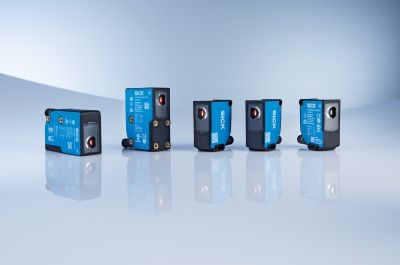SICK Introduces KTS and KTX Sensors
With its KTS and KTX product families, SICK is presenting new, powerful contrast sensors from a forward-looking, innovative platform. The patented TwinEye technology for improved contrast detection and sensing distance tolerance (+- 5 mm), the specially developed three-color LED with its high-precision, color-mixed light spot, and the jitter that has been minimized to a level never before seen, coupled with absolute high-speed switching frequencies, open up a world of new possibilities when it comes to detecting contrasts and – for the first time in a sensor – colors too.
IO-Link and additional integrated functions such as recipe management ensure maximum versatility, while the innovative, multifunctional 7-segment display guarantees simple yet customized sensor setup, operation, and visualization.
Familiar applications such as the detection of print marks or the control of industrial labeling processes benefit from even greater process stability and performance. The sensors detect high-gloss materials and complex contrasts, even on heavily jittering materials. The integrated color mode also enables reliable detection of even the most minor contrast differences and color features.
The KTX product family offers compatibility without compromise: Both the hole pattern for mounting the sensors and the electrical connectivity facilitate a 1:1 migration from the SICK product families that are already proven and widespread on the market to the new technology platform. In its space-saving compact housing, the KTS meets all requirements of modern machine concepts.
The KTS contrast sensors come in “CORE” and “PRIME” configurations; these offer different levels of functionality, enabling a variety of different automation needs to be met individually and cost-effectively. The even more finely granular grayscale resolution of the KTS and KTX, the integrated color mode, and the large number of other technical innovations in both product families are setting a new standard in the market for contrast sensor technology – and opening up additional areas of application at the same time, such as the detection of wafers, the management of reel changes, or quality control.





 Power Transmission Engineering is THE magazine of mechanical components. PTE is written for engineers and maintenance pros who specify, purchase and use gears, gear drives, bearings, motors, couplings, clutches, lubrication, seals and all other types of mechanical power transmission and motion control components.
Power Transmission Engineering is THE magazine of mechanical components. PTE is written for engineers and maintenance pros who specify, purchase and use gears, gear drives, bearings, motors, couplings, clutches, lubrication, seals and all other types of mechanical power transmission and motion control components.